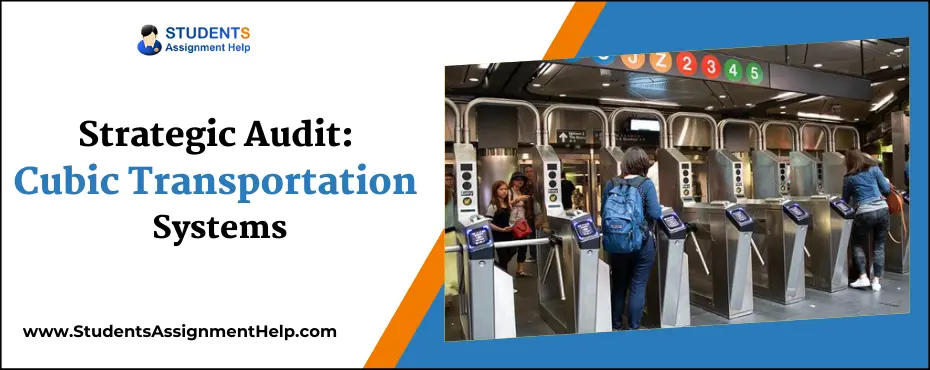Strategic Audit: Cubic Transportation Systems

Introduction
Cubic Transportation Systems, Inc. (CTS) is a highly advanced company that designs and produces automated fare collection systems for mass transit administries. The company deliver integrated fare collection systems that comprise access control, revenue control, fare payment, vending of cards, communications of data, and information management. In addition to this, the card and commercial services are also offered by the company, for instance hosting of central systems and functions, financial settlement, card making, distribution and marketing. The speciality of the company is its buses, trains and ferries ticketing and payment systems by using smartcards and mobile phones (Smartphones).
In this manner, it is apparent that company offers wide range of services that involves customer support, software support and operations services. Although, the company has wide global reach, but is striving to capture the market of Middle East and North Africa to tap these emerging markets and gain high revenues (Cubic Transportation Systems 2013).
External Environment Analysis
PEST Analysis
Political:
Cubic transportation Systems has to depend majorly on the federal, state and local government in order to get subsidies in capital ventures. At the same time, the company will have to depend on the government regulations of the country regarding procurement or up gradation of any systems in North Africa and Middle East (Opurum 2012).
The procurements in the both the countries go through a rigorous and lengthy competitive bid process, where companies bidding low prices will get significant advantage.
The standard lifecycle for fair collection in rail is 12 to 15 years and for buses it is 7 to 10 years (Multisystems, Inc, et al. 2002).
Stuck with a lot of homework assignments and feeling stressed ?
Take professional academic assistance & Get 100% Plagiarism free papers
Economic:
The trend of regional automated ticketing systems is growing in both countries.
In addition, there is a rising trend for other systems as well for increasing the convenience of the smart card to provide higher value and incentives to final customers (Acumen Building Enterprise, Inc, et al. 2006).
The economic opportunities for novel and innovative systems and support are high in mass transit in both Middle East and North Africa. Countries are increasingly choosing to outsource the ongoing functions and commercialization of ticketing systems.
The growing market presents vital opportunities for CTS to set up enduring relationships and increment its profits in the long run (Opurum 2012).
Socio-Cultural:
The demand for public transit is growing at a heavy rate in North Africa and Middle East due to heavy tourist arrival and growing business concern in these countries.
This has generated high demand for ticketing systems and other automated services in these aspiring markets (Middleton 2003).
The alterations in the cultural perspectives with respect to automated fare collection systems are another significant factor (Multisystems, Inc, et al. 2002).
Technological:
The current technological advancements around the globe have made it pertinent for the company to provide highly advanced products and services to customers in newly emerging markets and get their constant attention.
It is significant that progress in communications, security and networking technologies are allowing interoperability of numerous modes of transportation in a sole networked system and also interoperability of numerous operators in a single networked arrangement (Middleton 2003).
Porter’s Five Forces Analysis
Threat of New Entrants: The threat of new entrants is high in the new emerging because of the fact that these markets are new emerging one due to which companies will make efforts to tap the novel opportunities available to them for increasing revenues and profit margins. However, it is considerable that these markets also present significant challenges for companies, and thus, Cubic Transportation has an advantage because of its innovative and quality products and services. In addition, the strict government regulations and competitive bidding process for public transit makes the threat moderate (Ensign 2013).
Rivalry amongst Competitors: The intensity of competition is high for the company in both countries. It is considerable that automated fare industry involves high cost of exit. The major foreign competitors of the company are Thales, Scheidt & Bachmann and ACS. However, it is prominent to mention that Cubic is one of the many companies that offer automated fare collection solutions and systems for public transit operators around the world.
Additionally, number of local companies in the European, Middle East, and Asian markets also act as competitors for the company that strives for large national tenders. Moreover, fare collection organisations, computer service companies, telecommunications, and other such are also competitors (Cubic Transportation Systems 2013).
Bargaining Power of Consumers: The bargaining of customers is high in the industry as the public transport companies can adopt any company who bids in the most competitive manner and charge low price for offering their prices. The switching cost for customers is high in the industry and public transports are usually controlled by a single authority due to which the bargaining power is high (Ali 2009).
Bargaining power of Suppliers: The automated fare collection industry is a niche market that upholds by a number of suppliers. It is vital that the long life expectation of the solutions and ability of few companies to soppy products have created severe competition to get supplying contracts (Cubic Transportation Systems 2013).
Flexible Rates Compatible With Everyone’s Budget
Hire a Professional Essay & Assignment Writer for completing your Academic Assessments
The threat of Substitute Products: The threats of substitute products is also there for the company in the new markets as these markets are still relying on traditional ticketing systems for public transit, which somehow is challenging for the company. The lack of understanding of automated systems and level of complexity can play a big role for substitute products (Acumen Building Enterprise, Inc, et al. 2006).
Internal Environment Analysis
Resources:
Cubic transportation is the leading company that delivers built-in revenue management systems and solutions for the mass transit industry. The company has an enormous amount of tangible and intangible resources that will aid it while entering into new markets. The high financial stability, innovative engineers, dedicated employees, technologically advanced machines and highly automated business processes are some of the prominent tangible resources of the company.
In addition to this, the brand name which company has collected in some of the major international markets like Canada, Europe, UK and Australia, loyal customer base and the more than 400 projects, which it provides in 40 prime markets, is its enormous intangible resources (Cubic Transportation Systems 2013).
Capabilities:
The highly exceptional resources of Cubic have made it capable of offering innovative and advanced customer assistance, software assistance and operation services, The company is capable of delivering fare payment infrastructure in Middle East and North Africa comprising of gates, smart card readers, ticketing machines and central solutions for dealing and reporting any form of data and revenues (Cubic Transportation Systems 2013).
Core Competencies:
The comprehensive and extensive customer services that Cubic Transportation provides to customers are it major core competencies that aids in overcoming competitors from the market. The company is a specialist in its fare infrastructure and revenue management functions and upholding. The experienced operation’s employees of the company and their confident services accompanied with quality assured revenue infrastructure are core competencies that offer incomparable convenience and flexibility to customers. Moreover, the company has got performance of high standards and control in technology and innovation that acts as it core competencies in this highly competitive market (Cubic Transportation Systems 2013).
Buy high-quality essays & assignment writing as per particular university, high school or college by UK, USA & Australian Writers
Research of the Automated Fare Collection (AFC) Industry
It is significant to state that Automated Fare Industry is experiencing a rise these days in public transit because of the growing preference of people for technology advanced services that are more of flexible and convenience. Automated Fare collection not only reduced the manual process of ticketing and fare collection, but also make it highly effective to collect revenues from customers through an integrated ticketing systems and at the same time keeping it confidential and safe. Ticketing vending machines, fare gate, ticket terminals and other services are now much common in different countries with respect to public transit. In addition to this, computers are also using computers at depot and stations for data communications (Middleton 2003).
It can be stated that because of the fast pace of expansion of the rail transit construction, the demand level for AFC is going high and high. It is worth considering that with the hastening of subway and speedy rail investment and manufacturing in Middle East and North Africa, AFC systems market in these countries will also develop along with the rapid growth of these countries. Automated Fare Collections Industry is booming because such systems augment the efficiency of public transit by ensuring that passengers get a legitimate ticket when they enter public buses, ferries, and trains, and consequently they pay the appropriate fare for their journey (Opurum 2012).
Meanwhile, automated fare collection systems are also advancing in new markets because they make the process ticket accounting and ticket selling automated, and at the same time, delivers comprehensive information on system usage that brings down the deception by staff and travellers in public transit. Nowadays, the automated fare collection machines also uses smart cards that travellers can utilise for boarding in public transits in major cities. Moreover, a wide network of gates, transaction machines, and validators upholds systems. This not only facilitates passengers to purchase and renew their fare tickets or cards, but also permits public transit authorities make the boarding and money collecting process more speedy (Multisystems, Inc, et al. 2002).
Strategic Responses of Cubic Transportation Systems (Recommended strategy for new Markets)
In light of the research conducted of the automated fare collection industry and the global environment of in ticketing, it can be stated that it is appropriate for the company to espouse of the differentiation strategy and in this context, the company should made its offerings distinctive from competitors offerings so that public transit authorities will approach the company and its innovative products and services (Berry 2004).
For tapping the market of North Africa and the Middle East, the recommended strategy for Cubic is that it should integrate a basis for low-cost smart tickets in order to offer a complete smart card-based payment system to customers. This is because f the fact that smart tickets systems and vending machines are gaining high popularity due to their convenience and high accuracy (Hanson, et al. 2011).
The company should offer a complete package of card-enabled parking systems, as well that can be integrated in the regional systems. It is considerable that growing traffic of tourists and business people in Middle East and North Africa has made it necessary for public transit authorities to introduce such systems and this strategy of company will it in serving new markets in the best manner (Davidson 2006).
As a strategic response to the current and future issues, which the global business environment in ticketing is facing, it is vital for Cubic Transportation Systems to conduct feasibility studies and identify the best potential entry method in these new markets. The company should made efforts to identify the probability of Strategic Alliances, Joint Ventures and Acquisitions in these new markets so that it will espouse on the most feasible step and makes it entry more successful. As a business level strategy the company should strive for higher customer service through customer focussed systems and lower risk offerings by making them innovative and advanced (Hamel and Prahalad 1994).
The Key Risks Associated for Cubic if it Started a Venture in the Middle East and North Africa
Key Risks in the Middle East:
The legal framework of countries in this region will be a risk for the company as the legal policies in the countries of Middle East are stern and there is more social and political risk for companies starting new venture. The company will have to face high cultural differences that exist between Middle East and other foreign countries, which will be a risk for it as it has to amend it strategies accordingly as per the business environment and cultural needs of the country (Abdallah 2001).
The taxation policy and the structure of the country is more oriented towards the growth and development of domestic countries due to which it will be difficult for a foreign company to survive in the region. It is considerable the automated fare collection systems will be new in the region and some customers will have no idea and this poses high risk of customer ignorance and unawareness about the utility of such systems (Ali 2009).
Flexible Rates Compatible With Everyone’s Budget
Hire a Professional Essay & Assignment Writer for completing your Academic Assessments
Key Risks in North Africa:
The business image of North Africa is still highly turmoil and assertions are made by different researches that the country is still not ready for heavy investments. It is considerable that the region has faced heavy economic loss as a result of numerous upheavals and migration of foreign capital. The region suffers from social unrest and due to this risk; investors usually prefer to stay away from it. It is essential for Cubic to develop enough connections in North Africa to sustain for long term and reducing risks (Ensign 2013).
Evaluation of Cubic’s Ability to Effectively Implement the Strategies in the New Markets
It can be stated that the ability of Cubic is highly effective to implement the strategies in the new market despite the risks that these markets present to the company. This is because of the reason that Cubic has got the most efficient management team, high devoted staff members and innovative engineers that are the major strengths of the company and allow it to makes it mark in all the new markets.
Moreover, Cubic Transportation Systems has got an in-depth and comprehensive knowledge of the revenue management industry and automate fare collection services, which make it able to comply with the diverse demands of customers and customise products and services as per their needs and preferences. Cubic is well versed with the right mix of resources and competencies that will enable it to implement the business level strategy and tap new markets (Lei and Slocum 2005).
There is high probability of Cubic’s success in these markets because it offers customers a complete solution of proven systems that not only involves low risk, but is also exceptionally unique. The integrated solutions of Cubic allow authorities to supply a particular system, individual service or to operate the entire organisation. The constant focus on innovation with which company designs and provides its systems and maintenance services will aid businesses in cutting down their cost and augmenting their revenues. All these ability of Cubic will definitely enable it to implement the strategies in the new market and gain high success (Hamel and Prahalad 1990).
Conclusion
It can be concluded from the above discussion that Cubic Transportation Systems offers integrated revenue management solutions and offerings to public transit industry, the company is headquartered in the US and produces ticketing systems, vending machines, support systems and services for buses, trains and other public transports to make payments and buying tickets by using technology, smartcards and mobile phones.
The company is making efforts to expand in the Middle East and North Africa as these are merging markets for automated fare collection systems and will aid the company increasing its revenues. The discussion presents the internal and external analysis of the company by highlighting the enormous resources and exceptional core competencies, which it has got. Subsequently, strategic recommendations in the form of diffentitaion and focussed customer behaviour have been made to the company so that it will become able to mark its presence and earn high profits in these new markets.
References
Abdallah, W.M. 2001. Managing multinationals in the Middle East: accounting and tax issues. Greenwood Publishing Group.Acumen Building Enterprise, Inc, United States. Federal Transit Administration, Transit Cooperative Research Program, Transit Development Corporation, Booz Allen Hamilton, National Research Council (U.S.). Transportation Research Board. 2006. Smartcard Interoperability Issues for the Transit Industry. Transportation Research Board.
Ali, A. 2009. Business and management environment in Saudi Arabia: challenges and opportunities for multinational corporations. Taylor & Francis.Berry, T. 2004. Hurdle: The book on business planning (Millennium Edition). USA: Paolo Alto Software.Cubic Transportation Systems. 2013. [Online]. Available at: https://cts.cubic.com/en-us/home.aspx [Accessed on: 26 November 2013].Davidson, P. 2006. Management: Core Concepts and Skills. Australia: John Wiley & Sons.Ensign, R.L. 2013. Middle East and North Africa Voted Highest Risk Places To Do Business. The Wall Street Journal.
Hamel, G. and Prahalad, C.K. 1990. The Core Competence of the Corporation. Harvard Business Review, May–June. pp. 79-91.
Hamel, G. and Prahalad, C.K. 1994. Competing for the Future. Boston: Harvard Business School Press.Hanson, D., Hitt, M., Ireland, R., and Hoskisson, R. 2011. Strategic Management: Competitiveness and Globalisation. South Melbourne: Thomson.
Lei, D. and Slocum, J.W. 2005. Strategic and organisational requirements for competitive advantage. Academy of Management Executive, 19 (1), pp. 31-45.
Middleton, W.D. 2003. Metropolitan Railways: Rapid Transit in America. Canada: Indiana University Press.
Multisystems, Inc, Mundle & Associates, Parsons Transportation Group, United States. Federal Transit Administration, Transit Cooperative Research Program. 2002. A Toolkit for Self-service, Barrier-free Fare Collection. Transportation Research Board.
Opurum, C.N. 2012 Automated Fare Collection System & Urban Public Transportation: An Economic & Management Approach to Urban Transit Systems. USA: Trafford Publishing.







